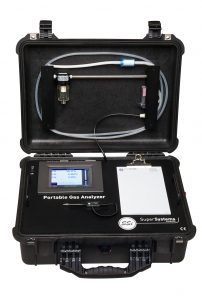PGA 3510
Portable 4-Gas NDIR Analyzer + Oxygen (% O2) – CO, CO2, CH4, H2
Precision Measurement of Protective Heat Treating Atmospheres
The portable gas analyzer can be used for the calculation of carbon in endothermic and nitrogen methanol based atmospheres with an input of temperature. This instrument meets CQI-9 requirements for daily generator and furnace atmosphere verifications.

| Accurate measurement of carbon based on gas composition |
| CQI-9 carbon potential verification device |
| Easy to operate |
| Built in sample pump |
| Battery operated |
| Easy to use on board calibration |
| Software utilities for printing charts |
| Field calibration for zero and span |
| Ethernet communications |
| Universal power (110 - 230 VAC) |
| Rechargeable battery |
| Available with ammonia-compatible design |
| Language editor |
| Data manager for downloading |
| Print charts and tabular data |
| Setup facility and furnace identifiers |
| Add notes when capturing data |
| Real time graphical display on PC |
| Export utilities |
| Backup data manager |
| PGA Utility Software for Configuration, Equipment, Language and Data Management with an Easy Interface |
| CO: Carbon Monoxide | Range: 0 - 30% |
| CO2: Carbon Dioxide | Range: 0 - 2.0% Optional Range: 0 - 20.0% |
| CH4: Natural Gas/Methane | Range: 0 - 20% |
| Optional H2: Hydrogen | Range: 0 - 100% |
| Calculated % Carbon | Range: 0.1 - 2.00% |
| Suggested COF / PF factors | |
| Onboard Data Acquisition | |
| Enhanced with Nitriding/FNC Calculations | Carbon Potential (KC) Nitriding Potential (KN) |
| Sampling method | Extraction by internal pump (when necessary) |
| Measurement Method (CO, CO2, CH4) | Non-Dispersive Infrared (NDIR) |
| Measurement Method (O2) | Electrochemical |
| Measurement Method (H2) | Thermal Conductivity |
| Accuracy and repeatability | ± 1% of full scale |
| Recommended Factory Calibration Interval | Annual |
| Flow Meter | Inside case lid and also on-screen |
| AC Power Requirements | 90 to 230 VAC, 50 to 60 Hz, 60 Watts |
| DC Power Source | 12VDC rechargeable NiCd battery with Integral charger |
| Communications | Ethernet, USB(A), USB(B), RS485 Modbus |
| Data Storage | Continuous automatic data logging |
| Data Retrieval | XGA Viewer Software (included) or on-screen |
| Operating Temperature | 32° to 122° F (0° to 50° C) |
| External Dimensions | Approx. 16”H X 20”L X 8”D |
| Weight | Approx. 28 lbs. |
| CO: Carbon Monoxide | Range: 0 - 30% |
| CO2: Carbon Dioxide | Range: 0 - 2.0% Optional Range: 0 - 20.0% |
| CH4: Natural Gas/Methane | Range: 0 - 20% |
| Optional H2: Hydrogen | Range: 0 - 100% |
| Calculated % Carbon | Range: 0.1 - 2.00% |
| Suggested COF / PF factors | |
| Onboard Data Acquisition | |
| Enhanced with Nitriding/FNC Calculations | Carbon Potential (KC) Nitriding Potential (KN) |
| The effectiveness of the catalyst is measured by the CH4 content. Less than 0.5% is an indication of properly functioning catalyst. Higher concentrations indicate the necessity for either conditioning or replacement. |
| Measuring the level of CO in the carrier gas allows for correction of the % Carbon reading at the furnace. |
| Furnace atmosphere Carbon potential (% C) can be verified with the PGA 3510 |
| Measuring Carbon Monoxide (CO) allows for adjustment of the COF/PF parameters to fine tune the % Carbon calculation in the furnace |
| Measuring Carbon Monoxide (CO) and Carbon Dioxide (CO2) can show possible problems (i.e. sooting, water leaks, air leaks, and radiant tube leaks) |
| Too much free Methane (CH4) could be an early indication of a furnace problem |
| The carbon monoxide (CO) level in the furnace atmosphere indicates the effectiveness of the cracking of the methanol. Equilibrium of this reaction CH3OH --> CO + 2H2 is temperature dependent |
| Furnace atmosphere carbon potential (% C) can be verified with the PGA 3510 |
| Measuring carbon monoxide (CO) allows adjustment of the COF/PF parameters to fine tune the % Carbon calculation in the furnace |
| Measuring Carbon Monoxide (CO) and Carbon Dioxide (CO2) can show possible problems (i.e. sooting, water leaks, air leaks, and radiant tube leaks) |
| Product Line | User Manual | Datasheet | Wiring | Other |
|---|---|---|---|---|
| PGA3500 | PDF | Online | |||
| PGA3510 | PDF | Online | PGA 3510 Datasheet | ||
| MGA 6000 | ||||
| MGA 6010 | PDF | Online | MZA 6010 Datasheet | ||
| RGA 6010 | PDF | Online | RGA Datasheet | ||
| MZA 6010 | PDF | Online | MZA 6010 Datasheet | ||
| XGA Viewer | ||||
| General Info | Atmosphere Measurement and Troubleshooting |
|||
| Touchscreen Cleaning Procedure | ||||
| An Overview of Endothermic Generators |
| If the device is used... | Then perform a calibration... |
|---|---|
| Daily | Weekly |
| Weekly | Monthly |
| Less than weekly | Prior to use |
SSi recommends 1.5 scfh. However, anywhere from 1 – 2 scfh is acceptable.
These are factors that go into the calculation for determining the %Carbon. Manually adjusting them will have a direct effect on the %Carbon being calculated. Contact SSi for more information.
To set the Device time to match the Touch screen date and time:
- Go to Menu and log in with the number 2.
- Then select “Instrument set up” > “General set up.”
- Edit the Device time to match the touch screen time by selecting “Device Time” > “Edit.”
- Call SSi at 513-772-0060 for a Code of the Day login number.
- Log in with the code.
- Select the “Factory use only” option.
- On the following screen select “Set Instrument Type.”
- Set the Nitrider Calculations option to Enable.
- You will then need to cycle power to have the correct Calculations page displayed.
The PGA displays a calculated dew point using gas values and requires assumptions regarding the composition of the gas being sampled. Since these assumptions are not always accurate, the resulting dew point is not always accurate.
The incoming pressurized gas goes through a small fixed orifice inside the analyzer, which should require between 20 and 50 psi to maintain proper flow.
- Remove the end caps from each side of the CO2 Scrubber.
- Go to the calibration screen of the PGA and turn the pump ON.
- Attach either end of the CO2 scrubber to the inlet tube of the PGA.
- Watch the zero calibration values until they drop to near 0.00%.
- Select “Start Calibration” and allow the green progress bar to start.
- Once complete, turn the pump off and then connect to your Span calibration gas.
- On the PGA , go to Menu and log in with the number 2.
- Then select “Tools” > “Database maintenance.”
- On this screen you can maintain equipment, users, and manage the equipment and sessions.
- Go back to the main menu and select “Sessions” to allow you to select your Operator, Equipment, and start the session.
SSi recommends using the included USB cable as follows:
- On your PC, open the installed XGA Viewer (make sure your PGA is also turned on).
- Using the provided USB cable, connect the B Connector to the “Client” port on the side of the PGA and the A connector to the PC.
- In XGA Viewer select “Options” > “Instruments set up.” This will open a Configure Analyzers window.
- On the bottom select “Add.” Here you can name the instrument and enter its serial number.
- Click the blue “Scan” button to scan the Network for your PGA.
- When the scan is completed you should see the PGA appear. Click on it.
- You will be returned to the Configure Analyzers window. Click “Save.”
Whenever you see the inside of the filter start to change color. The filter can be replaced by changing p/n 31033.
Go to the Windows 10 Start menu (bottom left corner).
Type “Services” in the Search Bar and click the Services icon.
Scroll down and double click on “Windows Mobile-2003-based devices connectivity.”
Select the “Logon” tab on the top of the screen.
Select “Local System account” and click “OK.”
Go back to the Services list, and double click on “Windows Mobile-based devices connectivity.”
Select the “Logon” tab on the top of the screen.
Select “Local System account” and click “OK.”


